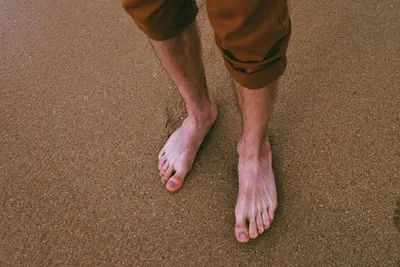Foot Problems – Metatarsalgia
Metatarsalgia Causes and Treatments
There are many causes of metatarsalgia, but the common one is repetitive force.
The second metatarsal is most frequently affected and can lead to many symptoms. These include a deep bruise and what feels like a rock under the ball of the foot.
Symptoms are often worse when walking barefoot on a hard surface, but they can also occur in well-cushioned shoes.
The ball of the foot can also develop a callus under the affected metatarsal.
Sports activities can also cause metatarsalgia. Activities such as running put continuous pressure on the ball of the foot, and abnormal stress can cause inflammation in this area.
Ligaments, tendons, and cartilage are irritated due to this abnormal stress. High heels and sneakers without arch support can also cause metatarsalgia.
These shoes can also lead to swollen bumps at the base of the big toe.
Forefoot Pain or Pain in the Ball of the Foot
The below terms all refer to pain in the balls of the feet (the area between the toes and the arch).
The most important structures in the balls of the feet are the five metatarsal heads (the ends of the metatarsal bones that connect to the toes) and the protective fatty pad that cushions the ball of the foot.
The pain in the ball of the foot, which is also known as metatarsalgia, can be sharp, dull, or even numb.
Some people experience pain only in one joint, but the pain can also radiate to the entire ball of the foot. Patients often experience tingling or numbness in the area, indicating an underlying condition.
If you are experiencing pain in the ball of the foot, your doctor can recommend treatments geared toward restoring the structure and function of the feet.
Custom orthotics are another option for patients with metatarsalgia.
These devices are designed to accommodate irregular walking patterns, affecting how weight is distributed across the balls of the feet.
By removing excessive weight in the ball of the foot, custom orthotics can provide symptomatic relief and help prevent the recurrence of painful symptoms.
The most common treatment for metatarsalgia is correcting the underlying problem.
Each time we take a step forward, we push off with our toes and the ball of the foot, forcing ourselves forward.
We force 100% of our body weight on these structures to do this. If they are not aligned perfectly or have insufficient fatty padding, we experience pain in the ball of the foot.
- 【Foot Pain Relief】Kelaide Arch support insoles built-in metatarsal pad designed to relieve and prevent pain from Flat Feet, Plantar Fasciitis, Metatarsalgia, Mortons Neuroma, and Ball of foot pain
- 【Neutral Arch Support】Orthotic Inserts stabilize and align the feet to help relieve and prevent pain from flat feet. Plantar Fasciitis insoles support the foot arch and are designed to reduce the excessive pressure on the Plantar Fascia ligament and provide relief from plantar fasciitis
- 【Metatarsal Pad】Metatarsal insoles are full-length insoles with metatarsal support. Created specifically for those with metatarsalgia, Morton’s Neuroma, and general ball of foot pain, these neutral arch-supporting insoles help alleviate pain in the ball of foot
- 【Shock Absorption & Breathable Material】Arch support inserts feature a soft layer of premium foam and breathable fabric that helps relieve heat and friction and provide the perfect blend of stability and cushioning while improving comfort and helping to reduce fatigue
- 【Designed For Everyday Use】The heel of the insoles are wrapped not too high there is enough room for most shoes to fit comfortably such as athletic, walking/running, work, and some casual and dress shoes. First-time metatarsal insoles users may need to get used to them for a while, adding some time each day to get used to them until they get used to wearing them all-day
Last update on 2025-11-19 / Affiliate links / Images from Amazon Product Advertising API
Causes of Pain in the Balls of the Feet: The normal foot consists of bones and joints held together perfectly by soft tissue structures known as ligaments, muscles, and tendons.
When this alignment is abnormal in the ball of the foot, we not only feel pain but frequently develop painful calluses in the underlying skin.
Calluses are symptoms of some abnormality in the bones and joints of the ball of the foot. The most common causes of pain in the balls of the feet are:
Dropped metatarsal (also known as plantarflexed metatarsal head or displaced metatarsal head):
Each foot has five metatarsals that connect to one of our five toes.
The metatarsals sit in a precise relationship, one to the other, forming the metatarsal arch (also called the transverse arch).
As we step down on the ball of the foot, the metatarsal arch begins to flatten in response to our body weight. This allows the ball of the foot to function as a shock absorber.
If one or more of the metatarsal heads sit lower than the other heads, it will bear a greater amount of our body’s weight than it should bear.
After a time, the dropped metatarsal head becomes “beaten up” from all the extra or abnormal weight it carries, inflamed and painful.
Also, because the metatarsal head has “dropped,” it is sitting closer to the skin on the bottom of the foot, pushing its protective fat pad away so that you may feel the protruding metatarsal head with your finger.
Due to this lack of a normal fatty pad under the metatarsal head, the head will apply abnormal pressure on the underlying skin.
The skin may respond to this increased pressure by building up a painful callus. Causes of a dropped metatarsal include:
A flexible foot. In this type of foot, the ligaments, tendons, and muscles are too lax to allow them to hold the bones and joints together in their most optimum alignment.
The most common cause of a flexible foot is a biomechanical defect known as pronation.
High-heeled shoes. When the heel is raised, our weight is thrown forward onto the foot ball. This increased weight stretches the soft tissues that maintain the metatarsal arch, allowing one or more of the metatarsal heads to drop.
- [POWERSTEP PINNACLE PLUS MET]: Full length insoles, built-in metatarsal pad for ball of foot pain, neutral arch support, maximum cushioning, high activity for moderate support.
- [FOOT PAIN PREVENTION AND RELIEF]: PowerStep Pinnacle Plus insoles are ideal for pain associated with Plantar Fasciitis, Achilles Tendonitis, shin splints and other foot, ankle, knee, hip & back pain. As the #1 Podiatrist recommended brand, our mission and purpose at PowerStep is to create a more comfortable and happier life for our customers. ~ The PowerStep Pain Free Life
- [NEUTRAL ARCH SUPPORT | METATARSAL SUPPORT | MAXIMUM CUSHIONING]: PowerStep Pinnacle Plus Met insoles are full-length insoles with a built-in metatarsal pad. Created specifically for those with metatarsalgia, Morton’s Neuroma and general ball of foot pain, these neutral arch supporting insoles help alleviate pain in the ball of foot. The proven PowerStep arch shape cradles the arch and heel, adding stability and motion control to limit excess stress on feet, ankles, joints, and tendons.
- [DESIGNED FOR EVERYDAY USE]: First time PowerStep or orthotic insole users may need a transition period of wearing insoles only a few hours a day until feet are accustomed to all day support and stability. PowerStep Pinnacle Plus Met insoles can be worn in a variety of shoe types such as; athletic, walking/running, work and some casual and dress shoes. Inserts are ordered by shoe size, no trimming required.
- [PROUDLY MADE IN THE USA]: Your 100% satisfaction is our #1 concern, and all our products are backed by our 30-day money back guarantee.
Last update on 2025-11-19 / Affiliate links / Images from Amazon Product Advertising API
Injuries to the ball of the foot. When fractured metatarsals or dislocated joints are not properly treated, they may heal in an abnormal position, allowing the metatarsal head to drop.
Thinning or destruction (atrophy) of the protective fat pad in the ball of the foot.
The fat pad in the ball of the foot functions as a shock absorber for the underlying bones, joints, and soft tissue structures.
When the pad is not of optimum thickness, the force and weight of each step we take are passed on to the underlying structures rather than absorbed and whisked away by the fat pad.
This eventually produces inflammation and pain in the soft tissues, bones, and joints in the ball of the foot.
As we age, the fatty protective pad begins to absorb. The rate of this absorption will depend on your genes.
A dropped metatarsal head will destroy the fatty pad between it and the skin.
Some diseases will cause the fatty pads in the feet to become thinner.
Examples of these diseases include rheumatoid arthritis, connective tissue disorders, and some endocrine diseases.
Excessive and prolonged pressure on the ball of the foot will cause the fat pad to be thinned or destroyed.
Some causes are high-heeled shoes, walking barefoot, or wearing shoes with very thin soles.
Feet with high arches: This foot type is usually rigid and will not allow the high arch to come into contact with the ground when we step down.
Therefore, as we step forward, all of our weight is thrown onto the balls of the feet rather than some of the weight being carried by the arch.
This will force the metatarsal heads in the balls of the feet to bear excessive weight.
The results of this repetitive and excessive weight on the metatarsal heads is pain, inflammation, and swelling in the balls of the feet.
Treatment for Pain in the Balls of the Feet:
To reduce the pain in the balls of the feet, we must do the following:
Rebalance the metatarsal heads, so that the dropped metatarsal heads are raised to their normal and most optimum positions.
This will ensure that each metatarsal head will bear its “fair share” of our body weight. When this occurs, the pain in the balls of the feet will gradually subside. Just padding the ball of the foot will not provide this relief.
To rebalance the foot, we must use a custom-made orthotic. Each person’s problem is truly unique.
To provide lasting relief, the treatment must be directed toward elevating your specific metatarsal head by the exact amount it has dropped.
When this is accomplished, the pain will subside, and the metatarsal arch is re-formed, allowing it to function as the body’s shock absorber.
This type of relief can only be obtained by using custom-made orthotics, which are made from molds of your feet.
Replace the fatty pad protection on the balls of the feet. In constructing with custom-made orthotics, you protect the balls of the feet with materials that will absorb friction and excessive pressure rather than passing them to the balls of the feet.
The materials used act as though more fat and padding were added to the feet without adding excessive bulk.
Support high arches to relieve excess pressure on the balls of the feet.
Custom-made orthotics are designed to comfortably allow this type of arch to function as if it were of a normal height.
By doing this, you allow the arch to bear its normal weight, thus reducing the weight that the ball of the foot must bear.
This will reduce the pressure on the metatarsal heads and fatty pads, thus reducing pain and fatigue.
Adjust and accommodate any abnormal walking patterns you have, such as pronation, in-toeing, out-toeing, etc., that affect how weight is distributed across the balls of your feet when you walk.
Custom-made orthotics will allow the feet to function normally when they strike the ground rather than in a twisted position, thus removing the excessive weight and pressure from the balls of the feet.









